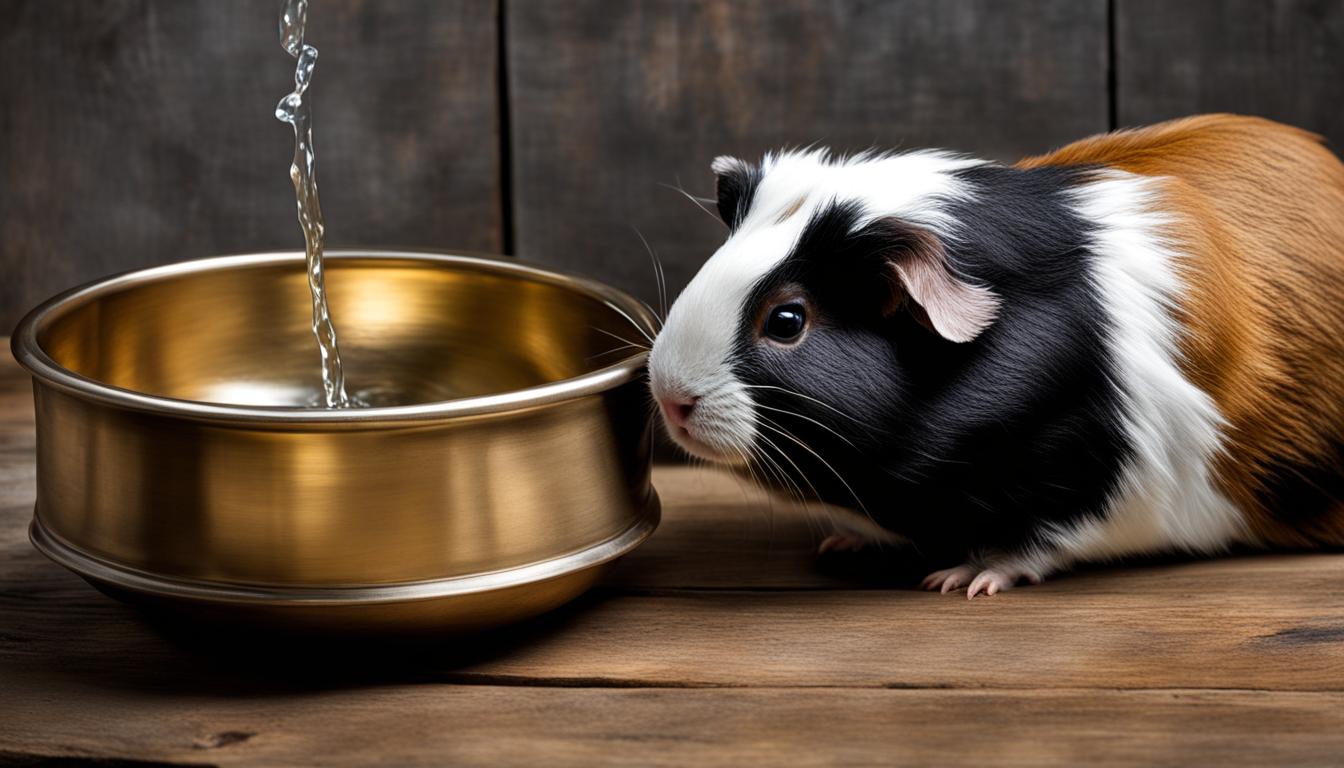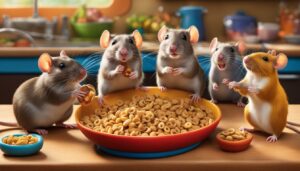Guinea pigs require water to survive and grow, just like people do. Water is necessary for many body processes, such as digestion, circulation, and temperature regulation.
One of the most important aspects of caring for your guinea pig is ensuring access to fresh, clean water.
Yes, guinea pigs can drink from a bowl. Using a bowl as a water source for your guinea pig can mimic their natural behavior, provide easier accessibility for certain guinea pigs, allow for easy monitoring of water intake, and reduce the risk of dripping compared to water bottles.
In this guide, I will discuss the debate surrounding using bowls for guinea pig water, the benefits and drawbacks, and how to safely use a bowl for your pet’s hydration needs.
Key Takeaways:
- Guinea pigs need access to fresh, clean water for their overall health and well-being.
- There is a debate about whether guinea pigs can drink from a bowl or if a water bottle is the better option.
- Bowls have benefits such as mimicking natural behavior and easier accessibility for certain guinea pigs.
- Water bottles have advantages such as cleanliness and minimal spillage.
- Regardless of the choice, it is important to prioritize your guinea pig’s hydration needs and monitor their water intake.
Water bottles have long been the go-to choice for providing hydration to guinea pigs. They offer several benefits that make them a popular option among pet owners.
First and foremost, water bottles help prevent contamination. Unlike bowls, which can collect debris and dirt, water bottles keep the water clean and free from any potential sources of illness.
Additionally, water bottles are portable, making it easy to provide fresh water to your guinea pig wherever they may be.
They also allow for easy monitoring of water intake, ensuring that your furry friend stays properly hydrated.
However, there are also some drawbacks to using water bottles for guinea pig hydration. One common issue is dripping.
Some water bottles may leak, causing wet bedding and potentially leading to discomfort for your pet.
Cleaning can also be a bit more challenging with water bottles compared to bowls. It’s important to regularly clean and disinfect the water bottle to prevent the growth of bacteria and keep your guinea pig healthy.
Despite these drawbacks, many guinea pig owners find that the benefits of using a water bottle outweigh the challenges.
It’s important to choose a high-quality water bottle that is designed specifically for small animals like guinea pigs.
Regularly check the water bottle for any signs of damage or leakage, and clean it frequently to ensure your guinea pig always has access to clean, fresh water.
Can Guinea Pigs Drink Out of a Bowl?
When it comes to providing water for your guinea pig, there has been some debate about whether using a bowl is a suitable option.
Let’s explore the benefits and drawbacks of using a water bowl for your furry friend’s hydration needs.
Benefits of a Water Bowl
- Mimics natural behavior: Guinea pigs in the wild drink water from various sources, including ponds and streams. Using a bowl can help replicate this natural behavior.
. - Easier accessibility: Some guinea pigs, particularly those with dental issues or mobility challenges, may find it easier to access water from a bowl rather than a water bottle.
. - Easy monitoring of water intake: With a bowl, you can easily see how much water your guinea pig is consuming, allowing you to ensure they are staying hydrated.
. - Less dripping: Unlike water bottles, bowls do not have the risk of dripping, which can lead to wet bedding and potential hygiene issues.
Drawbacks of a Water Bowl
- Contamination: Bowls can be prone to contamination from droppings, bedding, or other debris, which may require more frequent cleaning.
. - Spills: Guinea pigs can be playful and may accidentally tip over or splash water from the bowl, causing wet bedding and potential discomfort.
. - Regulating intake: Some guinea pigs may drink excessively from a bowl, leading to water-related health problems. It’s important to monitor their intake and ensure they do not consume too much water.
If you decide to use a bowl for your guinea pig’s water, it’s crucial to choose the right bowl, clean it regularly, monitor water levels, check for spills, and consider offering both a water bottle and a bowl as options.
By taking these precautions, you can provide your guinea pig with a safe and refreshing water source.
The Importance of Proper Hydration for Guinea Pigs
Adequate hydration is crucial for the overall health and well-being of guinea pigs. Just like humans, these adorable pets rely on water for vital body processes.
Without proper hydration, guinea pigs can suffer from various health problems, including kidney stones, dehydration, and urinary tract infections.
Water plays a key role in digestion, circulation, temperature regulation, and overall organ function in guinea pigs.
It helps keep their bodies functioning optimally and maintains their overall health. As responsible pet owners, it is our duty to prioritize their hydration needs by ensuring they have access to fresh, clean water at all times.
Dehydration can have serious consequences for guinea pigs, so it is important to pay attention to their water intake.
If you notice any changes in their behavior, such as increased lethargy or decreased appetite, it could be a sign of dehydration.
Providing them with water-rich foods, such as leafy greens and cucumbers, can also help supplement their hydration.
The Potential Health Problems from Dehydration in Guinea Pigs
- Kidney Stones: A lack of adequate water intake can lead to the formation of kidney stones in guinea pigs. These painful stones can cause urinary blockages and discomfort.
. - Dehydration: Without sufficient water, guinea pigs can become dehydrated, leading to various health issues. Dehydration can affect their overall well-being and may require veterinary intervention.
. - Urinary Tract Infections: Lack of hydration can increase the risk of developing urinary tract infections in guinea pigs. These infections can be uncomfortable and may require medical treatment.
By understanding the importance of proper hydration and taking proactive steps to ensure your guinea pigs have access to fresh water, you can help keep them healthy and happy.
Whether you choose a water bottle or a bowl, the key is to prioritize their hydration needs and monitor their water intake regularly.
Choosing the Right Bowl for Your Guinea Pig
In this section, I will discuss the important factors to consider when selecting a water bowl for your guinea pig.
It is crucial to choose a bowl that is heavy and tip-resistant to prevent any accidental spills or messes. A stable bowl will ensure that your guinea pig can drink comfortably without knocking over the bowl.
Look for bowls with a wide and shallow design, as this will make it easier for your guinea pig to access the water without any difficulties.
Cleaning the guinea pig water bowl is also a vital aspect of maintaining hygiene. Make sure to clean the bowl daily to prevent contamination and the growth of harmful bacteria.
Use mild dish soap and warm water, and rinse the bowl thoroughly to remove any soap residue. It is essential to dry the bowl completely before refilling it with fresh water to prevent any moisture buildup.
Overall, choosing the right water bowl for your guinea pig is crucial for their hydration needs. Opt for a heavy and tip-resistant bowl, clean it regularly, and provide fresh water daily to ensure your furry friend stays healthy and hydrated.
The Pros and Cons of Water Bottles for Guinea Pigs

When it comes to providing hydration for your guinea pig, water bottles have long been the go-to choice for many pet owners.
But like any other option, water bottles come with their own set of advantages and disadvantages. Let’s take a closer look at the pros and cons:
Advantages of Water Bottles for Guinea Pigs:
- Hygiene: Water bottles help keep the water clean and uncontaminated, reducing the risk of bacteria growth and potential health issues.
. - Easy Monitoring: With a water bottle, it’s easy to keep track of your guinea pig’s water intake, ensuring they are staying properly hydrated.
. - Minimal Spillage: Water bottles are designed to minimize spillage, which means less mess and less risk of wet bedding or living areas.
Disadvantages of Water Bottles for Guinea Pigs:
- Leaking: Some water bottles may develop leaks over time, leading to wasted water and potentially wetting your guinea pig’s living space.
. - Cleaning Difficulties: Water bottles can be challenging to clean thoroughly, requiring extra care to remove any built-up residue or bacteria.
. - Challenges for Young or Elderly Guinea Pigs: Young or elderly guinea pigs may struggle to access water from a water bottle, especially if they have mobility issues or are not familiar with using one.
Ultimately, the decision to use a water bottle for your guinea pig’s hydration needs depends on your personal preferences and your ability to address the potential drawbacks.
It’s important to regularly check the bottle for any leaks and to clean it thoroughly to ensure your guinea pig has access to fresh, clean water at all times.
Maintaining Hygiene with a Guinea Pig Water Bowl
If you choose to use a bowl for your guinea pig’s water, it is essential to prioritize hygiene to ensure your pet’s health and well-being. Here are some tips for maintaining cleanliness and preventing contamination:
- Clean the bowl regularly: To prevent the growth of bacteria and algae, clean the water bowl daily with mild soap and warm water. Rinse thoroughly to remove any residue.
. - Monitor water levels: Check the water bowl regularly to ensure that it is filled with fresh, clean water. Guinea pigs need a constant supply of water, so refill as necessary to prevent dehydration.
. - Address spills promptly: Accidental spills can occur, causing wet bedding and potential discomfort for your guinea pig. Clean up any spills immediately to maintain a clean and dry environment.
By following these practices, you can provide your guinea pig with a clean and hygienic water source, reducing the risk of contamination and promoting their overall health.
Preventing Contamination
Contamination can occur if the water bowl is not cleaned regularly or if debris, such as bedding or food, falls into the water. To prevent contamination:
- Place the water bowl away from food and bedding: Position the bowl in a separate area to minimize the chances of debris falling into the water.
. - Use a shallow bowl: Opt for a shallow bowl to make it easier for your guinea pig to drink without dipping their face into the water, reducing the risk of contamination.
By implementing these measures, you can minimize the risk of contamination and ensure that your guinea pig’s water remains clean and safe for consumption.
The Final Verdict: Bowl or Water Bottle?

When it comes to choosing between a bowl and a water bottle for your guinea pig’s water, there is no one-size-fits-all answer.
It ultimately depends on your guinea pig’s preferences and your ability to maintain hygiene. Some guinea pigs may prefer drinking from a bowl as it mimics their natural behavior, while others may prefer the convenience and cleanliness of a water bottle.
It’s important to observe your guinea pig and see which option they are more comfortable with. Some guinea pig owners have found success by offering both a bowl and a water bottle, allowing their pets to choose.
This way, you can ensure that your guinea pig has access to water in a way that they prefer.
Regardless of the choice you make, the most crucial aspect is to prioritize your guinea pig’s hydration.
Always provide fresh, clean water and monitor their intake to ensure they are staying properly hydrated. Remember, water is essential for their overall health and well-being, so make it a top priority in their care.
Tips for Keeping Guinea Pigs Hydrated
Ensuring that your guinea pigs stay hydrated is essential for their overall health and well-being. Here are some helpful tips to keep your furry friends properly hydrated:
1. Provide fresh water daily
Make sure your guinea pigs have access to clean, fresh water at all times. Replace the water in their bowl or water bottle daily to prevent bacteria growth and contamination.
Guinea pigs may not drink the entire contents of their water container in one go, so it’s important to refresh it regularly.
2. Monitor water intake
Pay attention to how much water your guinea pigs are drinking. While there is no exact amount that they should consume, monitoring their water intake can help you identify any changes in their drinking habits, which might indicate a health issue.
If you notice a significant decrease in their water consumption, it’s important to consult a veterinarian.
3. Offer a variety of water sources
In addition to a water bottle or bowl, you can provide your guinea pigs with alternative sources of water. Some guinea pigs prefer to drink from a bowl, while others may prefer a water bottle. Offering both options can help accommodate their preferences and ensure they are getting enough hydration.
Remember, guinea pigs are prone to dehydration, so it’s crucial to prioritize their hydration needs.
By following these tips and providing fresh water, monitoring intake, and offering different water sources, you can help keep your guinea pigs happy and healthy.
Conclusion
In conclusion, after exploring the benefits and drawbacks of using a bowl for guinea pig water, it is clear that guinea pigs can indeed drink from a bowl.
While traditional water bottles have been the go-to choice for many guinea pig owners, bowls offer advantages such as mimicking natural behavior and easier accessibility for certain guinea pigs.
However, it is important to note that bowls also come with their own set of challenges, including the risk of contamination and spills.
To safely use a bowl, it is crucial to select a heavy and tip-resistant bowl, clean it regularly to prevent bacteria growth, monitor water levels to ensure freshness, and promptly address any spills or wet bedding.
In the end, whether you choose to use a bowl or a water bottle for your guinea pig’s hydration needs, the most important thing is to prioritize their well-being by providing fresh, clean water and monitoring their intake.
By taking these steps, you can ensure that your furry friend stays properly hydrated, promoting overall health and happiness.
FAQ
Can guinea pigs drink from a bowl?
Yes, guinea pigs can drink from a bowl. However, there are some considerations to keep in mind when using a bowl as a water source for your pet.
What are the benefits of using a water bowl for guinea pigs?
Using a bowl mimics natural behavior, provides easier accessibility for certain guinea pigs, allows for easy monitoring of water intake, and reduces dripping.
What are the drawbacks of using a water bowl for guinea pigs?
Some drawbacks include contamination, spills, difficulties in regulating intake, and potential challenges for young or elderly guinea pigs.
How can I safely use a bowl for my guinea pig’s water?
To safely use a bowl, it is important to select a heavy, tip-resistant bowl, clean it regularly to prevent contamination, monitor water levels, check for spills, and consider offering both a water bottle and a bowl as options.
Why is proper hydration important for guinea pigs?
Adequate hydration is crucial for guinea pigs’ health and well-being. Water is necessary for various body processes, and a lack of fluids can lead to health problems such as kidney stones, dehydration, and urinary tract infections.
How do I choose the right bowl for my guinea pig?
Select a heavy, tip-resistant bowl that your guinea pig cannot easily overturn. Ensure it is easy to clean and has a suitable size for your pet’s needs.
What are the advantages of using a water bottle for guinea pigs?
Water bottles are convenient, easy to maintain, help prevent contamination, and allow for easy monitoring of water intake. They are also portable and minimize spillage.
What are the disadvantages of using a water bottle for guinea pigs?
Some disadvantages include issues with dripping, cleaning difficulties, and challenges for young or elderly guinea pigs.
How do I maintain hygiene with a guinea pig water bowl?
Maintain hygiene by regularly cleaning the bowl to prevent contamination and the growth of bacteria, monitoring water levels, and addressing any spills or wet bedding promptly.
Should I use a bowl or a water bottle for my guinea pig?
The choice between a bowl and a water bottle depends on your guinea pig’s preferences and your ability to maintain hygiene. Offering both options and allowing your pet to choose can be a good solution.
What are some tips for keeping guinea pigs hydrated?
Regularly check the water supply, monitor water intake, provide fresh water daily, and observe your guinea pigs’ behavior and health for any signs of dehydration.




